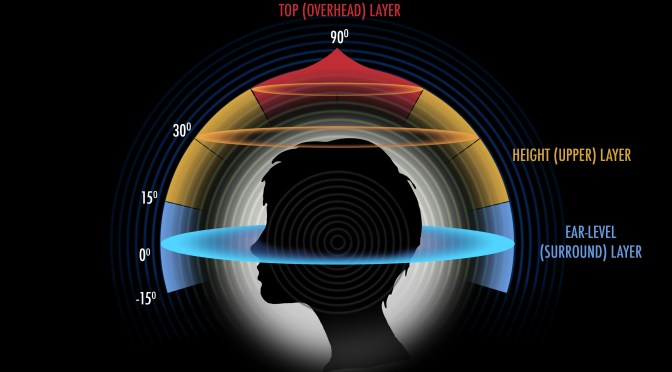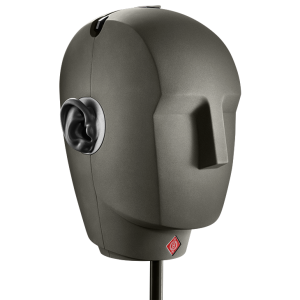(fig. Auro-Head-Graphic -2D, Quelle: 360cameraonline.com)
Immersive Audio-Aufnahmen in VR, sowie in 360 Grad-Videos, haben die unvergleichbare Fähigkeit, den Zuschauern einen Sinn für Dimension und Präsenz in einem neuen Raum zu geben1.. Sie erlaubt, die Aufmerksamkeit des Zuschauers subtil zu lenken und gibt ihm ein Gefühl von Materialität und Distanz. Der Begriff von räumlichem Audio deckt verschiedene Aufnahme/Wiedergabe Möglichkeiten ab (Siehe Definitionen aus dem Artikel „A beginner’s guide to spatial audio in 360-degree video”) und ist derweil noch in der Entwicklungsphase.
Sowie bei der visuellen Aufnahme in 360-Grad, bleibt das Wissen über die Anwendung der 3D Audio-Aufnahme empirisch. Eine Reihe von praktischen Tipps, welche von Professionellen des Audio-Bereichs entwickelt wurden, sind allerdings schon auf online-Plattformen zu finden. Sie betreffen meistens A) die optimale Positionierung des Aufnahmegeräts, B) die Bevorzugung eines kleinen Raums gegenüber eines Größeren, um gewisse Aktionen erkennen zu können, C) das Problem der Postproduktion bei aufgenommenen Bewegungen, welche durch „Stitch-Linien“ geschehen, D) die Notwendigkeit die visuelle und Audioaufnahmegeräten räumlich anzugleichen und E) das Aufnahmeverfahren im Detail zu dokumentieren.
—————————————————-
Definitionen:
(Quelle: „Spatial audio, defined”, In: Michael, N. (2017), „A beginner’s guide to spatial audio in 360-degree video”, url: training.npr.org)
“Stereo audio is the most basic spatial audio. It’s recorded in discrete left and right channels. In headphones, you’d be able to easily place sounds on a two-dimensional axis, from left to right.
Surround sound audio — in most cases — relies on engineers to mix multiple audio channels for playback on numerous speakers that literally surround an audience. You’ve probably heard surround sound in movie theaters, where it’s presented by companies like DTS, THX and Dolby.
Binaural audio delivers a fully 360-degree soundscape through a specially-encoded stereo file that has to be experienced through headphones. It models the way sound reflects around the head and within the folds of the ear. In fact, it is often recorded with a microphone that mimics the size and shape of a human head. You can hear in every direction, but the audio is not responsive to user input — if you move your head, the audio doesn’t change accordingly. The industry refers to this as “head-locked” audio.
(Fig. Kunstkopfaufnahmegerät – Neumann KU 100, Quelle: http://digitalaudioservice.de)
Audio Grafik einer binauralen Audioaufnahme:
Audio Grafik, Josh Laincz, Uy Tieu, Binaural Audio, url: https://apps.voxmedia.com/graphics/theverge-binaural-recording/
Beschreibung und Geschichte der Binaural audio:
YouTube Video, „Hear New York City in 3D audio”, The Verge, url: https://www.youtube.com/watch?v=Yd5i7TlpzCk
Beispiel: Lincoln – Beck: Hello Again – making off – 360Experience:
(Quelle: Vimeo, url: https://vimeo.com/231042730)
Ambisonics or 3D audio delivers a fully 360-degree soundscape that is responsive to a visual field. When you move your head in one direction or another, the audio changes to reflect that movement.
Interessante Beispiele von 3D Audio:
YouTube Video (2016), „3D Spatial Audio: Crossroads (360 Video)”, Junho Lee, url:
www.youtube.com/watch?v=Oue_XEKHq3g
YouTube Video (2016), „360 Video with Ambisonics Audio Demo”, Marc Weber, url:
www.youtube.com/watch?v=bKV1IS-ATmQ
YouTube Video(2016), „Reeps One: Does Not Exist – VR Beatbox with 3D sound”, Reeps One, url:
www.youtube.com/watch?v=OMLgliKYqaI
YouTube Video (2017), „Ambisonic Audio Test: sound changes as you turn your head around”, Brookline Interactive Group, url:
www.youtube.com/watch?v=vUtEW6OTQLw
—————————————————-
- Michael, N. (2017), „A beginner’s guide to spatial audio in 360-degree video”, url: training.npr.org

